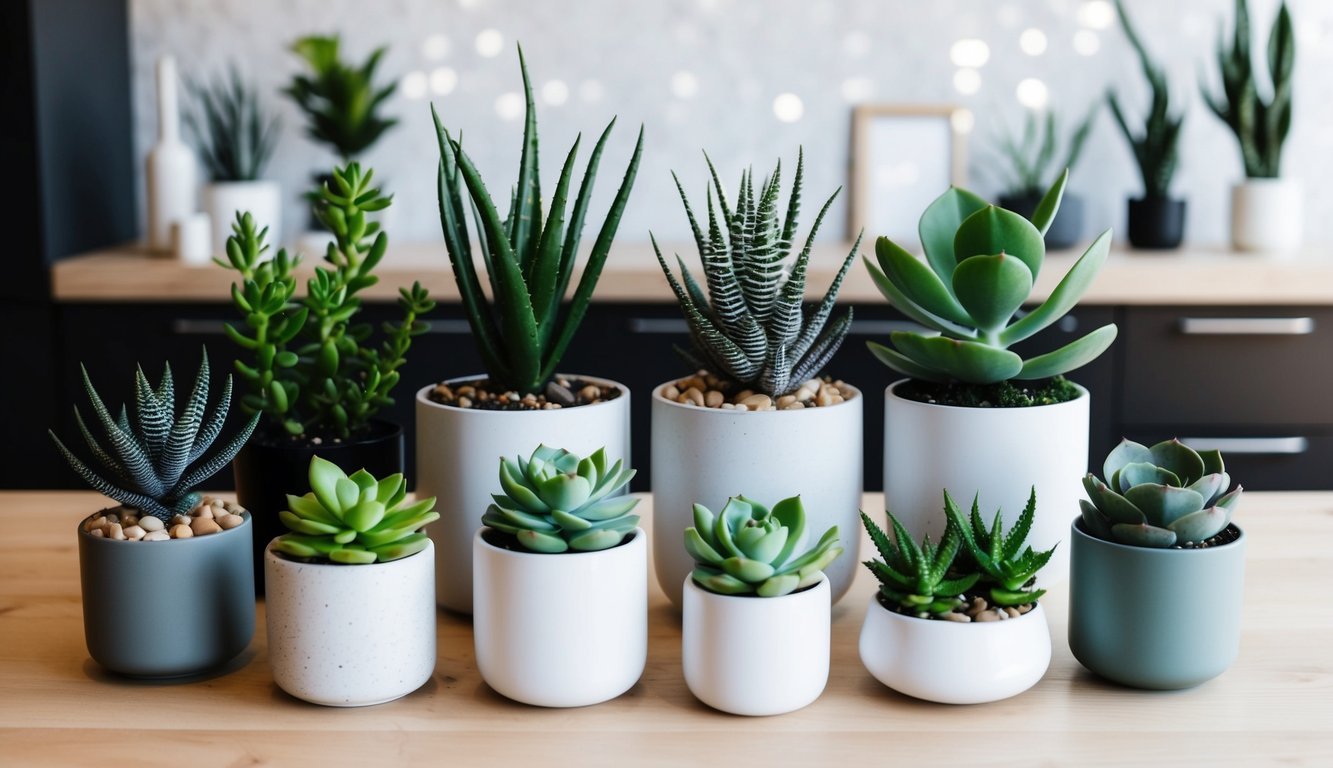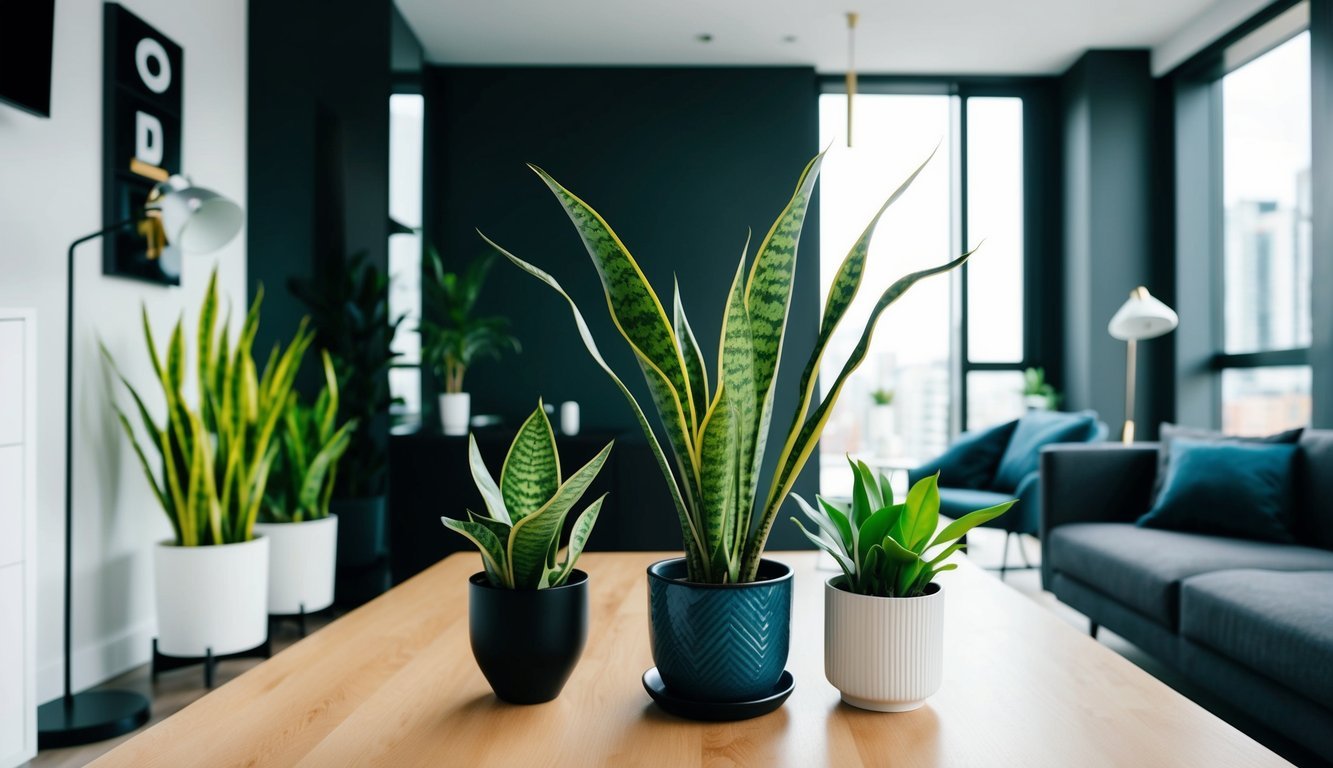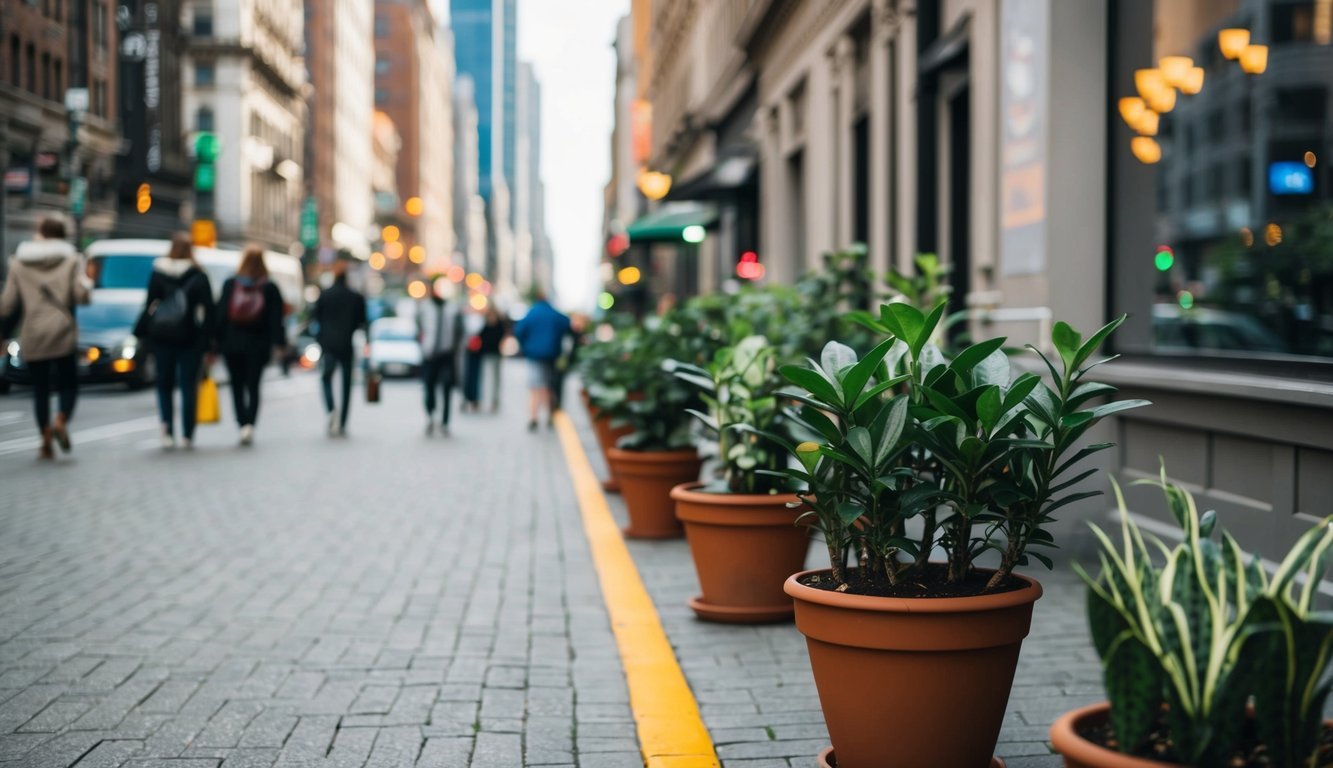Living in an urban environment often means juggling a busy schedule, which can make caring for plants feel overwhelming.
It’s easy to think that maintaining greenery in my space is a challenge, especially when time is limited and I keep pushing watering aside. For those of us with hectic lifestyles, low-water plants offer a perfect way to enjoy the beauty of nature without the constant upkeep.

These resilient plants not only add aesthetic appeal to my home but also thrive with minimal effort.
Choosing the right varieties means I can bring a little green into my life without the stress of regular maintenance.
The trick is finding those low-water options that suit my style and fit seamlessly into my urban lifestyle.
Succulents

I love succulents for their ease of care.
These plants thrive on minimal water, which makes them perfect for my busy lifestyle.
They can survive in a range of light conditions, from bright indirect light to full sun.
With their unique shapes and colors, succulents add a fun touch to any space.
I often mix different varieties to create interesting arrangements.
They look great in pots, terrariums, or even vertical gardens if I’m short on space.
One of the best things about succulents is how forgiving they are.
If I forget to water them for a while, they bounce back without any issues.
This resilience is a game-changer for anyone who might struggle with plant care.
Finding the right succulent is simple, as there are countless varieties to choose from.
I can easily pick one that fits my style, whether I prefer the more classic Echeveria or something a bit quirky like a string of pearls.
Including succulents in my home has made plant parenting enjoyable and hassle-free.
2) Lavender
I love lavender for its fragrant blooms and low water needs.
It’s a perfect choice for urban settings where space and time are limited.
There are many lavender varieties, but I find the dwarf types work best in smaller gardens or even pots.
Dwarf Munstead, for instance, reaches about 15 inches tall and thrives in growing zones 5-9.
This variety not only requires minimal watering but also offers stunning purple flowers and aromatic foliage.
I enjoy cutting a few stems for my home to enjoy the scent.
Another favorite is ‘Hidcote’, known for its deep lilac blooms.
It grows bushy and can tolerate cooler temperatures, making it resilient.
Lavender also attracts pollinators, which adds life to any outdoor space.
Plus, its drought resistance means I don’t have to worry about constant watering.
It’s a versatile plant, ideal for busy lifestyles.
Whether in a garden bed or a container on my balcony, lavender adds beauty and practicality.
3) Snake Plant

I’ve found the Snake Plant to be a fantastic addition to my home.
Also known as Sansevieria or Mother-in-Law’s Tongue, it thrives on neglect.
This means I don’t have to stress about watering it every week.
The Snake Plant’s striking upright leaves make it a visually appealing choice.
I love how they can stand tall in any corner, adding a touch of greenery without much effort.
Not only is it low-maintenance, but it also purifies the air.
It effectively removes toxins like formaldehyde and benzene, making my living space healthier.
I can go weeks without watering, thanks to its drought-resistant nature.
It tolerates a range of lighting conditions, from low light to bright indirect light, so I don’t have to worry about where I place it.
Caring for a Snake Plant is simple.
I just wipe the leaves occasionally to keep them dust-free.
When needed, a light misting or a spray of Neem oil can help, but usually, it’s perfectly fine on its own.
4) Spider Plant

The spider plant is one of my favorites for its resilience and unique look.
Its long, arching leaves add a bit of flair to any space without demanding too much attention.
I find spider plants incredibly easy to care for.
They prefer lightly moist soil but can survive if I forget to water them occasionally.
This makes them ideal for my busy lifestyle.
Temperature isn’t much of a concern either.
As long as it’s above 50°F, my spider plant stays happy.
It can handle a range of light conditions, though indirect light works best.
Additionally, they produce “pups,” which are small offshoots that look adorable hanging down.
I love propagating these in new pots to expand my indoor garden with minimal effort.
The spider plant truly embodies low-maintenance elegance.
5) ZZ Plant
The ZZ Plant, or Zanzibar Gem, is one of my favorite low-water plants.
It’s perfect for someone like me who has a busy lifestyle and might forget to water regularly.
This plant thrives in low-light conditions, which is a huge plus for urban living.
Whether I place it in a dim corner or a bright room, it seems to manage just fine.
I appreciate that it can go long periods between waterings.
I only need to water it when the soil is completely dry.
When I do, I make sure to water until it flows out of the drainage hole.
Another interesting thing is that it’s mildly toxic, so I keep it out of reach of pets.
I also enjoy how easy it is to propagate.
With a simple cutting, I can create new plants to share with friends.
The ZZ Plant really checks all the boxes for a low-maintenance, stylish addition to my home.
6) Jade Plant

I’ve found that jade plants are a fantastic choice for busy urban lifestyles.
They don’t need much water, which makes them perfect for my hectic schedule.
These succulents thrive in bright light and can tolerate some shade.
I usually place mine near a window where it gets about 4-6 hours of sunlight daily.
This keeps the leaves vibrant and healthy.
One of the best parts is their resilience.
Jade plants can live for years with the right care, making them lasting companions.
I really enjoy watching them grow and flourish.
I also appreciate that they are easy to propagate.
If I need a new plant, I can simply take a leaf cutting and let it root.
For soil, I prefer a well-draining mix, typically designed for succulents.
This ensures that the roots stay healthy without sitting in excess moisture.
With minimal care, jade plants bring a touch of greenery into my home without adding stress.
They add a bit of life to my space and are a great choice for anyone looking to keep plants.
7) Peace Lily
The Peace Lily is one of my favorite low-water plants.
It’s beautiful and easy to care for, which is perfect for my busy lifestyle.
I love how it can thrive in low to medium light.
That means I can place it in various spots around my home without worrying if it’s getting enough sun.
Watering is simple—I usually wait until the top inch of the soil is dry.
I’ve found that giving it filtered water helps keep the plant happy.
Humidity also plays a role.
The Peace Lily enjoys a bit of humidity, so it thrives in my bathroom or kitchen.
It does a great job of purifying the air too.
I really appreciate having a plant that not only looks good but also makes my home feel fresher.
Maintenance is minimal, just occasional leaf cleaning and a monthly fertilizer during the growing season.
This makes it a go-to choice for anyone looking to brighten their space without too much fuss.
Understanding Low-Water Plants
Low-water plants are a game-changer for urban dwellers like me, making gardening manageable even with a busy lifestyle.
These plants not only survive in dry conditions but can thrive with minimal care, which is perfect for those of us juggling various responsibilities.
Benefits for Urban Dwellers
Choosing low-water plants offers significant advantages for anyone living in a city.
First, they require less maintenance, freeing up my time to focus on other activities.
These plants are also eco-friendly.
By using species that need little irrigation, I help conserve water, which is especially important during those hot summer months.
Additionally, low-water gardening can lead to cost savings.
With reduced water usage, I notice lower utility bills.
- Low maintenance: Less watering means more free time.
- Eco-friendly: Contributes to water conservation.
- Cost-effective: Saves money on water bills.
Key Characteristics of Resilient Plants
Resilient low-water plants share specific traits that make them suitable for urban environments.
Most notably, they have deep root systems.
This allows them to access moisture from deeper soil layers, enabling them to survive during dry spells.
These plants often possess waxy or hairy leaves, which help reduce water loss.
This characteristic is a big plus for adapting to fluctuating weather conditions.
Another key feature is their ability to tolerate poor soil quality.
Many low-water species thrive in less-than-ideal conditions, making them perfect for urban gardens, which often have compacted or contaminated soil.
- Deep roots: Access moisture efficiently.
- Waxy leaves: Minimize water loss.
- Soil adaptability: Thrive in various soil types.
Tips for Caring for Low-Water Plants

Caring for low-water plants can be straightforward, but it’s easy to make mistakes if you’re new to it.
I’ve learned some key points that can help keep these resilient beauties thriving with minimal effort.
Common Mistakes to Avoid
One of the biggest pitfalls is overwatering.
Many low-water plants, like succulents, thrive on neglect.
They often prefer to dry out completely between waterings.
I recommend checking the soil moisture before adding more water.
If the top inch feels dry, it’s time to water.
Another mistake is poor soil choice.
I’ve discovered that using well-draining soil is crucial.
A mix that includes sand or perlite will help prevent root rot.
Additionally, avoid placing low-water plants in overly shady areas.
They usually need plenty of sunlight to thrive.
Lastly, be mindful of pests.
These plants are often more susceptible to issues if they’re stressed, so keep an eye out for any signs of infestation.
Best Practices for Watering
When it’s time to water, I find that using a watering can with a narrow spout allows for targeted application.
This method helps me avoid flooding the base of the plant, which can lead to root problems.
For most low-water plants, watering every two weeks is a good rule.
During hotter months, I adjust this according to how dry the soil feels.
Early morning is the best time to water, as it allows the plants to absorb moisture before the heat of the day.
Remember to observe each plant’s needs.
Some drought-tolerant varieties might require slightly different care.
Using moisture meters can be handy for ensuring I’m not underwatering or overwatering.

